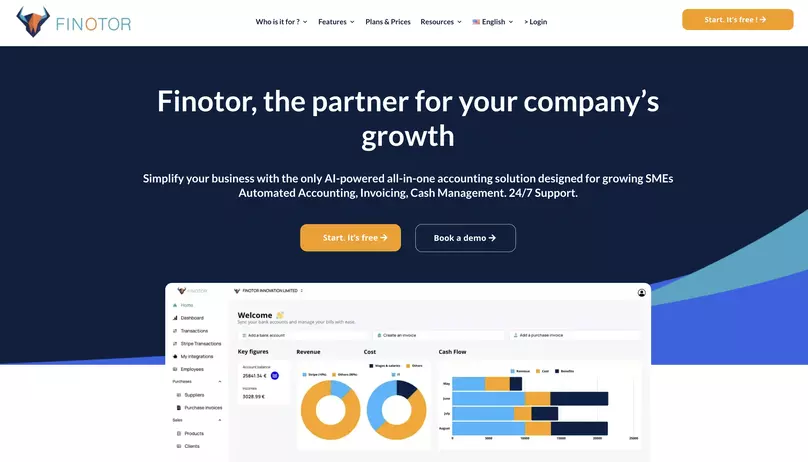Contents
- 1 Modular solutions for businesses of all sizes
- 2 Global scale and enterprise reinvention
- 3 Designed for developers, built for growth
- 4 Managing Your Stripe Account
- 5 Leveraging Stripe for financial innovation
- 6 Stripe with Finotor
- 7 Pricing and Plans
- 8 FAQ: Stripe’s Payment Platform – A Game-Changer for Online Businesses
Discover the secret weapon of online businesses
Stripe’s payment platform and Stripe account revolutionizes online transactions and financial management with its comprehensive, adaptable solutions to accept payments. Here’s a quick overview :
- Modular approach : Customizable components for businesses of all sizes
- Global reach : Support for 135+ currencies and international markets
- Developer-friendly : API-first design with extensive documentation
- Enterprise solutions : Advanced features for high-volume transactions and analytics
- Innovation catalyst : Enables new financial models and integrates with AI-powered tools
As a seasoned business advisor with over 15 years of experience guiding companies towards growth, I’ve witnessed the evolution of online payment systems. In today’s digital age, Stripe’s payment platform stands out as a comprehensive solution for seamless online transactions and financial management. Let’s delve into the key aspects that make Stripe a game-changer in the world of e-commerce and digital finance.
A new stripe account for a new business !
Modular solutions for businesses of all sizes
Stripe account offers a wide array of modular solutions designed to cater to businesses of various scales and industries. From startups to enterprise-level corporations, Stripe provides tailored services to meet specific needs, making it easy for users to sign up for new accounts or services. As of 2024, Stripe processes hundreds of billions of dollars annually, showcasing its robust infrastructure and global reach.
The platform’s versatility is evident in its support for over 135 currencies and payment methods. This extensive coverage allows businesses to expand their reach and tap into international markets with ease. Having co-founded multiple businesses supporting corporate development, I can attest to the importance of such flexibility in today’s interconnected global economy.
Additionally, integrating Stripe with existing systems is made convenient through Single Sign-On (SSO), allowing seamless access and management capabilities.
Stripe account modular approach includes :
- Online payments processing
- In-person payments with Terminal
- Payment Links for no-code payments
- Checkout for prebuilt payment forms
- Elements for flexible UI components
These components can be mixed and matched to create a customized payment ecosystem that aligns perfectly with a company’s unique requirements. This level of adaptability is crucial for businesses looking to stay competitive in rapidly evolving markets.
Global scale and enterprise reinvention
Stripe account global presence is a testament to its commitment to facilitating worldwide commerce. With offices scattered across the globe, the company has positioned itself as a truly international player in the fintech space. This global scale allows businesses to operate seamlessly across borders, a feature that’s particularly valuable for enterprises looking to reinvent themselves in the digital age.
The platform’s enterprise-level offerings are designed to support large-scale operations with complex needs. These include :
- Connect for payments on platforms
- Treasury for financial accounts
- Capital for customer financing
- Issuing for physical and virtual cards
As someone who has guided numerous companies through digital transformations, I’ve seen firsthand how Stripe account for enterprise solutions can revolutionize financial operations. The platform’s ability to handle high-volume transactions, coupled with its advanced fraud prevention system (Radar), provides a secure foundation for businesses to scale rapidly.
Moreover, analytics and reporting tool for a Stripe account, Sigma, offers invaluable insights into transaction data, enabling data-driven decision-making. This level of financial intelligence is crucial for enterprises seeking to optimize their operations and stay ahead of the competition.
Designed for developers, built for growth
One of Stripe’s most compelling features is its developer-friendly approach. The platform’s API-based integration and comprehensive developer tools make it a favorite among tech-savvy businesses. This focus on developer experience aligns perfectly with the growing trend of digital transformation across industries.
Here’s a breakdown of Stripe’s developer-oriented features :
| Feature | Benefit |
|---|---|
| API-first design | Flexible integration into existing systems |
| Extensive documentation | Rapid implementation and troubleshooting |
| SDKs for multiple languages | Compatibility with various tech stacks |
| Webhooks | Real-time event notifications |
These features not only streamline the integration process but also provide a solid foundation for scalable growth. As businesses expand, Stripe’s platform grows with them, offering advanced features like Billing for subscriptions and usage-based pricing, Revenue Recognition for accounting automation, and Tax for sales tax & VAT automation.
In my experience guiding startups through their growth phases, I’ve found that Stripe’s scalability is a significant advantage. It allows companies to start small and rapidly scale their payment infrastructure as they expand, without the need for major system overhauls.
Managing Your Stripe Account
Managing your Stripe account is a crucial part of ensuring the smooth operation of your business. Here are some key aspects to consider:
- Account Security: Protecting your Stripe account is paramount. Enable two-factor authentication (2FA) to add an extra layer of security, and ensure your password is strong and unique. Regularly review your account activity through the Stripe dashboard to monitor for any suspicious transactions and take immediate action if needed.
- Account Settings: Keeping your account information up-to-date is essential. Regularly update your business name, address, and contact details to ensure accuracy. This not only helps in maintaining a professional image but also ensures that all communications and transactions are correctly attributed to your business.
- Team Management: Stripe allows you to invite team members to access your account. You can assign specific roles and permissions to control what each team member can see and do. This feature is particularly useful for businesses with multiple departments handling different aspects of financial management.
- Notifications: Stay informed about important events by setting up notifications. You can configure alerts for new payments, disputes, or any updates to your account. This proactive approach helps you stay on top of your business operations and respond promptly to any issues.
- Data Export: Analyzing your Stripe data can provide valuable insights into your business performance. Stripe allows you to export data, including transactions, customers, and subscriptions. This data can be used to optimize your business strategies and improve overall efficiency.
By effectively managing your Stripe account, you can ensure a secure, efficient, and well-organized payment system that supports your business growth.
Leveraging Stripe for financial innovation
As we look towards the future of financial management, it’s clear that innovation will play a crucial role. Stripe’s platform serves as a catalyst for such innovation, enabling businesses to explore new financial models and services. From supporting the creator economy to facilitating crypto companies, Stripe is at the forefront of emerging financial trends.
One area where I see tremendous potential is the integration of AI-powered financial management solutions with Stripe’s infrastructure. For instance, Finotor, an AI-based accounting and financial analysis software, can leverage Stripe’s data to provide even more comprehensive financial insights. This synergy between payment processing and intelligent financial analysis can unlock new levels of efficiency and strategic planning for businesses.
Furthermore, Stripe’s commitment to sustainability through initiatives like Climate for carbon removal demonstrates a forward-thinking approach that resonates with environmentally conscious consumers and businesses alike. This alignment with global sustainability goals can be a significant differentiator for companies looking to appeal to a socially responsible customer base.
Stripe’s payment platform represents more than just a tool for processing transactions. It’s a comprehensive ecosystem that empowers businesses to innovate, scale, and thrive in the digital economy. As we continue to navigate the complexities of global commerce, platforms like Stripe will undoubtedly play a pivotal role in shaping the future of financial management and online transactions.
Stripe with Finotor
Stripe can be connected to Finotor. And to do this, Finotor has gone to great lengths to exploit the information that Stripe can provide.All too often, we see software that connects with Stripe, only to end up exploiting its surface.
With Finotor and Stripe, you can :
- Have all Stripe transactions in Finotor without having to go back and forth between 2 interfaces. This saves you time and ensures that your information is processed securely.
- Direct access to Stripe payout details. Tools such as Xero, Freshbooks or Quickbooks don’t provide this detail directly at the Payout. With Finotor, in just 1 click, you’ll know what you’re cashing in, which customers, details of charges, refunds, etc.
- Automatic bank reconciliation based on AI to perform the same bank reconciliation for Stripe transactions. You don’t have to do a thing. Everything reconciles directly and your accounting is done automatically. Automatic bank reconciliation based on AI is a real asset for users looking for time savings, security and performance.
- Customers who have paid via Stripe will be directly and automatically recorded in Finotor. No more data entry and no more wasted time. The customer works for you.
- Products created in Stripe are also automatically registered in Finotor. This again saves time for the Finotor user.
- If you have Stripe Billing, invoices created in Stripe are also directly and automatically registered in Finotor. Your accounting is up to date without you having to do a thing.
- Once the payment has been registered in Stripe and the invoice created, the invoice status changes to “Paid”, so your sales indicators are automatically updated too. And you can send the invoice from Finotor in 1 click, with a customizable message and the option of additional attachments.

> How can connect Stripe to Finotor ?
Pricing and Plans
Stripe offers a range of pricing plans to suit different business needs. Here are the details:
- Pay-as-you-go: Stripe’s standard pricing plan is straightforward and transparent. You pay a percentage of each transaction, plus a fixed fee per transaction. This model is ideal for businesses of all sizes, providing flexibility without long-term commitments.
- Custom Pricing: For larger businesses with specific needs, Stripe offers custom pricing plans. These plans can be tailored to your business requirements, ensuring you get the best value for your high-volume transactions and unique payment processing needs.
- Discounts: Stripe provides discounts for high-volume businesses, non-profit organizations, and businesses that use Stripe’s payment processing services in multiple countries. These discounts can significantly reduce your overall transaction costs, making Stripe an even more attractive option for large-scale operations.
- Additional Fees: While Stripe’s pricing is generally straightforward, there are additional fees for certain services. These include payment method fees, dispute fees, and currency conversion fees. It’s important to review these details to understand the full cost of using Stripe’s services.
- Stripe Billing: Managing recurring payments and subscriptions is made easy with Stripe Billing. This service is priced separately from the standard pay-as-you-go plan and offers advanced features for handling subscription models, usage-based pricing, and automated recurring payments.
Understanding Stripe’s pricing and plans allows you to choose the best option for your business, ensuring you get the most out of Stripe’s powerful payment platform.
FAQ: Stripe’s Payment Platform – A Game-Changer for Online Businesses
1. What is Stripe’s payment platform and how does it accept payments?
Stripe is a comprehensive payment platform designed to facilitate online and in-person transactions. It offers customizable solutions for businesses of all sizes, including payment processing, billing, and financial management tools.
2. How does Stripe support global businesses?
Stripe supports over 135 currencies, making it easier for businesses to operate globally. It allows seamless transactions across international markets, enabling companies to expand their reach and tap into new customer bases.
3. What are the key features of Stripe for developers?
Stripe is known for its developer-friendly approach with features like API-based integration, extensive documentation, SDKs for multiple languages, and real-time event notifications through webhooks. This flexibility allows for easy integration into various systems.
4. Can Stripe handle high-volume transactions for large enterprises?
Yes, Stripe offers enterprise-level solutions such as Connect for platform payments, Treasury for financial accounts, Capital for customer financing, and Issuing for physical and virtual cards. These features cater to businesses handling large transaction volumes.
5. How does Stripe help businesses with subscription services?
Stripe provides Billing for managing subscription services, usage-based pricing, and automated recurring payments. This helps businesses streamline subscription models and grow their customer base efficiently.
6. How can businesses leverage Stripe’s dashboard and data for financial insights?
Stripe’s Sigma tool offers advanced analytics and reporting, giving businesses valuable insights into transaction data. This enables data-driven decision-making, helping businesses optimize their operations and improve financial outcomes.
7. What are some security features of Stripe?
Stripe includes advanced fraud prevention tools like Radar to accept payments, which helps detect and prevent fraudulent transactions in real-time. This robust security system ensures safe and secure financial operations for businesses of all sizes.
8. Is Stripe suitable for startups as well as large enterprises?
Yes, Stripe’s modular approach allows startups to begin with basic services and scale up as their business grows. With features like Payment Links, Terminal for in-person payments, and Checkout, Stripe adapts to the needs of businesses at every stage of growth.
9. How does Stripe integrate with AI tools for financial management?
Stripe’s API and data can integrate with AI-powered tools like Finotor for enhanced financial insights. This combination enables businesses to automate financial analysis and gain real-time insights, improving strategic planning and decision-making.
10. What makes Stripe different from other payment platforms?
Stripe stands out for its flexibility, global reach, developer-friendly design, and ability to handle complex financial operations. Its enterprise solutions, fraud detection, and financial intelligence tools make it a leading choice for businesses aiming to scale and innovate.
11. Can Stripe help with tax automation?
Yes, when you open a new stripe account, Stripe offers a Tax feature that automates sales tax and VAT calculations, ensuring compliance with local tax regulations. This simplifies tax management for businesses operating across multiple regions.
12. How does Stripe align with sustainability goals?
Stripe has a dedicated initiative called Climate, which helps businesses contribute to carbon removal projects. This forward-thinking approach resonates with environmentally conscious businesses and customers, making Stripe an attractive choice for companies committed to sustainability.









